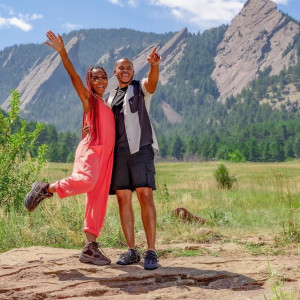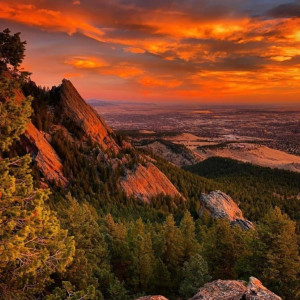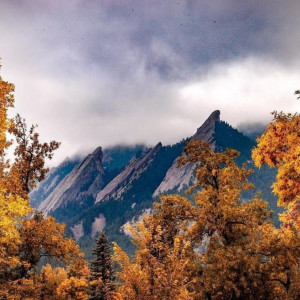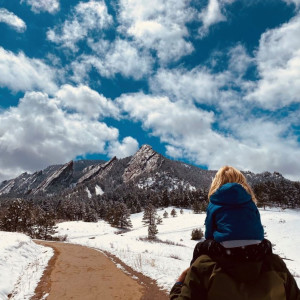The Insider’s Guide to the Flatirons
The Flatirons are the striking, slanted, reddish-brown sandstone formations that make up a portion of Boulder’s foothills on the west side of town. They are Boulder’s most iconic landmark, and you’ll see their likeness in business logos and artwork throughout town.

A Snowy Stroll at the Foot of the Flatirons
Whether frosted with snow, cloaked in fog, or glowing warm and red under sunny skies, the Flatirons offer the quintessential Boulder view. Once you snap a few shots of them from afar, head toward the foothills to explore them up close.
You can help protect their natural beauty by remembering these Leave No Trace principles.
Winter Hotel Deals Too Good to Miss
Stay cozy this winter with specials from Boulder's hotels.
See All Deals
3 Ways to Explore the Flatirons
The Flatirons belong to the more than 46,000 acres of Boulder’s protected Open Space & Mountain Parks, giving both locals and visitors extensive recreational access to these rocky towers (as well as providing habitat for wildlife ranging from squirrels and rabbits to bats and falcons to bears and even mountain lions). Here are our three favorite ways to explore them:
Please yield to people going uphill. That’s the etiquette for hikers in Boulder, the thought being it takes more energy to go uphill than down.
Hiking
Plenty of trails will take you around and up to the Flatirons, and many of them start from the Chautauqua Trailhead, off Baseline Road. Please allow adequate time for parking, as this can be very a busy area (and on summer weekends consider the Park to Park shuttle). Before you embark on your adventure, stop by the Ranger Cottage on the south side of the main parking lot for restrooms, free maps, brochures, hiking suggestions and the latest information about weather, trail conditions and wildlife closures.
For an easy-to-moderate hike, take the two-mile Flatiron Loop Trail, winding through the forest beneath the Flatirons. Another option is the hike to Woods Quarry, where you’ll get a view into the site of a historic sandstone quarry, plus enjoy a spectacular view from the stone benches that were assembled by some industrious visitors. These trails travel through ponderosa pine forest, over rocky scree fields, and across open fields, offering various views of the Flatirons and Boulder along the way.
Accessibility Info
The City of Boulder's Open Space and Mountain Parks program has assembled an excellent set of resources for hikers using wheelchairs, walkers and scooters at AccessibleOSMP.org. It includes an excellent series of subsequent five- to six-minute, fast-motion videos that show an entire accessible trail hiked by wheelchair.
The city has also published an incredibly thorough and helpful 40-page accessible trails guidebook (PDF) available for those seeking information about accessible hiking trails in Boulder.
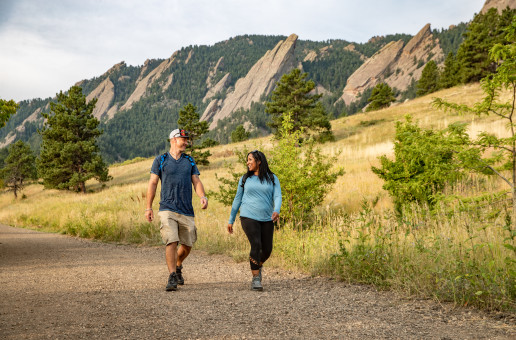
Rock Climbing
The best way to get up close and personal with the Flatirons? Climb them! (With a proper guide or previous experience and skillset, of course.) The First and Third Flatirons offer some of the most popular multi-pitch rock climbing routes in the area (and country!). The trail to the First Flatiron climbing access can be challenging, but you’ll be rewarded with long, varied climbs that range from about 4-10 pitches. The popular Third Flatiron, which offers even more routes, is usually closed to climbers and hikers from early February to late July to protect nesting raptors. Over the years, climbers have scaled the Third Flatiron while wearing roller skates, under the full moon without headlamps, and even while completely naked! But maybe save that for your next trip. Here's more information about climbing the Flatirons.
Accessibility Info
Paradox Sports in Boulder specializes in adaptive climbing opportunities for people with physical disabilities.
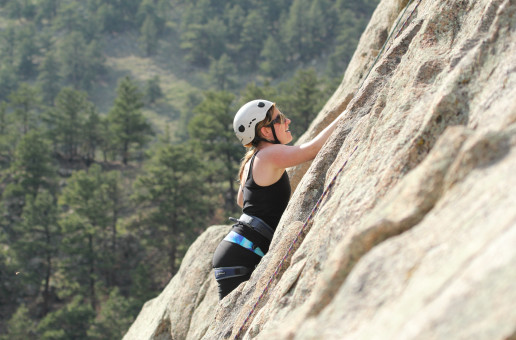
Rock Climbing with Colorado Wilderness Rides and Guides
On most OSMP trails in this area, dogs must be on a hand-held leash at all times unless they meet the voice and sight control standard and display a City of Boulder Voice and Sight tag.
Picnicking
Not feeling up to a hike or climb? You can still get your fill of the Flatirons — while filling your belly. Pack a picnic (spring through fall we recommend buying your provisions at the Boulder Farmers Market on Wednesday evening or Saturday morning, or grabbing a sandwich or ice cream at the park's own General Store on other days) and spread out a blanket on the grassy lawn at Chautauqua Park. This is the perfect spot to enjoy a meal under the Flatirons while watching the parade of people (and their pooches) heading up the hill for a hike. Afterward, you can hit the tennis courts, take the kids for a spin around the playground or catch a show at Chautauqua Auditorium.

Picnicking at Chautauqua Park
Park-to-Park FREE Summer Shuttle
Headed to the Chautauqua area on a summer weekend to hike among the Flatirons? Ride the free weekend shuttle, a short, 10-minute-or-so-ride, to get there stress-free and avoid parking fees. Here's all the information on the free Park-to-Park hiker shuttle, which operates on weekends from Memorial Day to Labor Day.
Accessibility Info
The Park to Park shuttle is fully wheelchair accessible. Chautauqua Park has accessible sidewalks and paths, restrooms and benches. You can reference the Chautauqua Ranger Cottage page (page 7) in the City of Boulder's OSMP Accessible Trails and Sites PDF for more information on surfaces, grades, parking and more.
Sharp eyes will see the huge letters “CU” (for the University of Colorado) near the top of the Third Flatirons. These were painted on the rock by two CU freshmen in 1949.
A Bit of History
These geologic formations are nearly 300 million years old. Although we know them today as “the Flatirons,” in the early 1900s they were called the “Chautauqua Slabs” or “The Crags.” When pioneer women said they thought the rocks looked like flat, metal irons used to iron their clothes, the name “Flatirons” stuck.
There are five numbered Flatirons, which run north to south along the eastern slope of Green Mountain in Southwest Boulder. These are what people usually mean when they refer collectively to “The Flatirons,” though you can also include numerous other named formations, such as the Seal, Devil’s Thumb, the Flying Flatiron and the Matron.

The Flatirons
Winter is the perfect time to hike the Flatirons. You won't need snowshoes, just hiking boots and possibly snow cleats (such as Yak Trax) for traction.
More Ideas For You
Hikes with Amazing Views
Be rewarded with sweeping panoramas
Boulder Coffee Crawl
Every indie coffee shop in Boulder, on a single map
4 Spectacular Wilderness Escapes
Close to Boulder, far from ordinary








